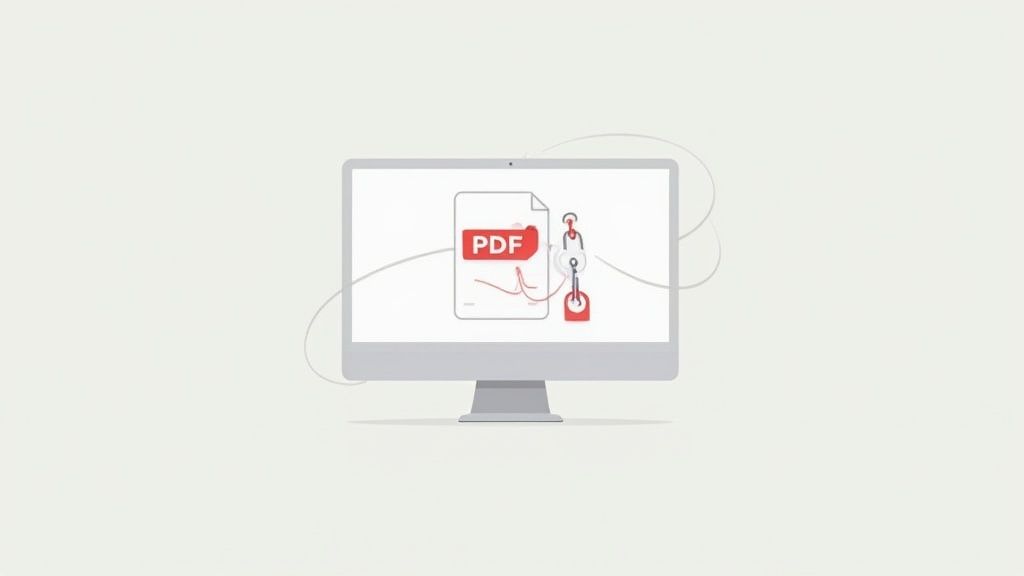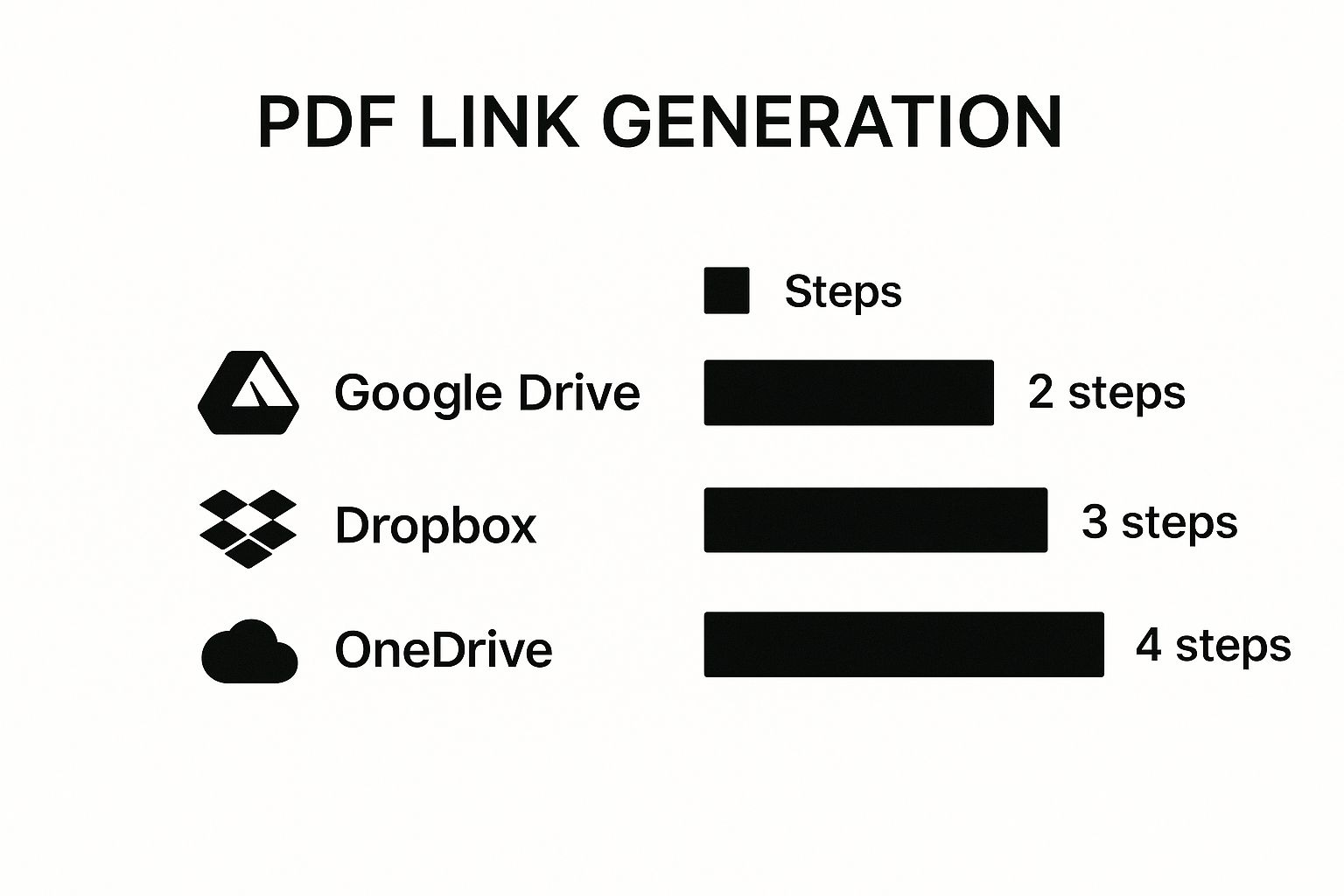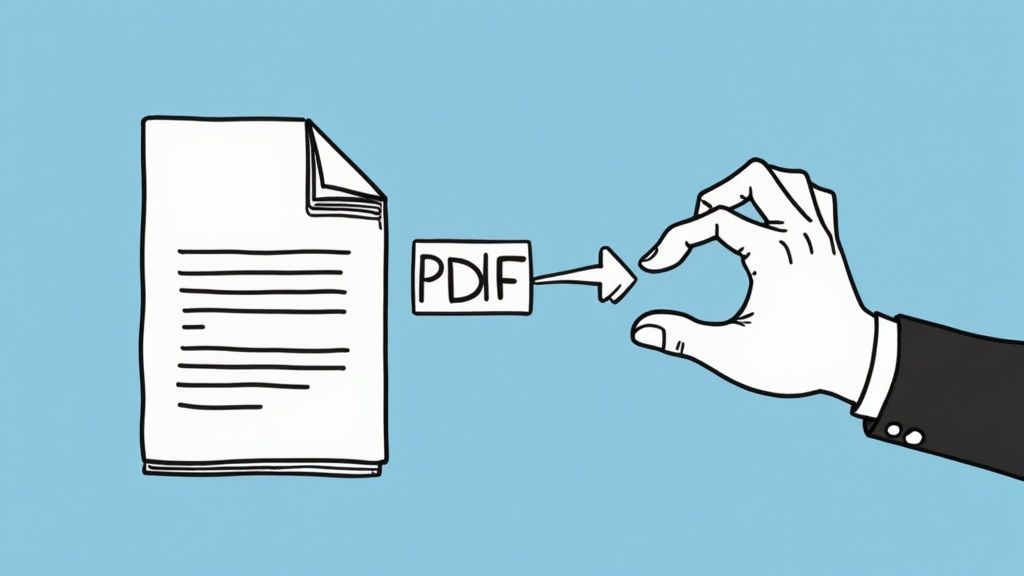How To Generate PDF Link: Smart File Sharing Strategies

Published : Jul 8, 2025
Written by: Madeson Sykes
15 minutes read
Why PDF Links Beat Traditional File Sharing Every Time

Ever sent a large proposal via email, only to have it bounce back? Talk about a productivity killer. That’s where sharing PDFs via a link comes in. It’s a total game-changer. It’s not just about avoiding file size limits; it’s about taking control of your document sharing. Think tracking who accesses it, updating the PDF without resending, and just generally looking more professional than with a clunky attachment.
For example, I was sending a media kit to a potential partner. Attaching the PDF was my first instinct, but it was huge. Instead, I used Href.sh to create a short, shareable link. It looked way cleaner in the email and, here’s the kicker, I could actually see when they viewed the kit. Perfect timing for a follow-up. That kind of insight is gold.
This whole move towards link-based sharing reflects a bigger shift in how we work. Digital document management is booming. Almost 65% of organizations are using cloud-based systems or web apps that create and share PDF links right from their platforms. This trend mirrors the growing use of PDFs across the board. Learn more about the global rise of digital business and PDF use here.
Plus, using a PDF link just feels more secure for the recipient, too. People are more likely to click a simple link than download a large attachment, which can sometimes trigger security flags. It’s a small tweak, but it can seriously boost your document’s open and engagement rates. Bottom line? PDF links are a more effective and efficient way to get your information out there.
Mastering Href.sh For Effortless PDF Link Creation
Sharing PDFs can sometimes feel like a hassle, right? I used to wrestle with clunky file-sharing services and confusing permissions until I discovered Href.sh. It’s become my go-to for quickly getting PDFs online without any fuss. It’s all about simplicity.
From upload to sharing, it’s incredibly smooth. Just drag and drop your PDF onto the Href.sh website. Boom. Instant, short, shareable link. You can even customize that link to be more professional and on-brand. For example, when I send client proposals, I personalize the link with the project name, like client-proposal-xyz.sharebob.app/. Small touch, big impact. Plus, their free tier is great for experimenting with different sharing methods.
Why Href.sh is Simpler Than Other Platforms
To illustrate just how simple Href.sh is, take a look at this comparison:

This infographic shows the steps involved in creating a PDF link on Google Drive, Dropbox, and OneDrive. Notice the difference? Href.sh cuts out the navigating through endless menus and sharing settings. It’s streamlined and efficient. Want to try it out? Upload your first PDF to Href.sh here.
More Than Just Simple Sharing
Beyond the simple upload, Href.sh offers features I’ve found genuinely helpful. I’ve heard from colleagues how its reliability has saved them in last-minute situations, keeping clients happy and projects on track. For me, it’s indispensable for managing my documents. They even have password protection and expiration dates, which are essential for sensitive information. This level of control is invaluable, adding another layer of professionalism and security.
To see how it stacks up against the competition, take a look at this feature comparison:
Href.sh vs Popular Alternatives: Feature Comparison A detailed comparison of key features between Href.sh and other PDF hosting platforms
| Platform | Free Tier | Custom Domains | Password Protection | Analytics | Ease of Use |
|---|---|---|---|---|---|
| Href.sh | Yes | Yes | Yes | Yes | Easy |
| Google Drive | Yes | No | Yes | Limited | Medium |
| Dropbox | Yes | No | Yes | Limited | Medium |
| OneDrive | Yes | No | Yes | Limited | Medium |
As you can see, Href.sh offers a competitive feature set, especially given its focus on ease of use. While others might provide larger storage capacities in their free tiers, Href.sh prioritizes quick and easy sharing, making it a strong contender for your PDF hosting needs. Its blend of simplicity and robust features makes it a winner in my book.
Exploring Alternative Platforms When You Need More Power
Href.sh is great for its simplicity. But let’s be real, sometimes you need more horsepower. Think larger projects, collaborating with clients, or needing specific features. I’ve seen this firsthand working with agencies, consultants, and educators. Sometimes, other platforms just fit their needs better. For example, I worked with a marketing agency that switched to Box because they absolutely needed that enterprise-level security for their client data. They loved how easy Href.sh was, but security was non-negotiable.
Choosing the Right Platform for Your Needs
So, when do you actually need more than Href.sh? Well, if you’re collaborating with multiple people on a project, Google Drive is a game-changer. The real-time editing and commenting features are invaluable. I’ve used it for co-authoring ebooks, and it just makes the whole process so much smoother. On the other hand, if you’re juggling a lot of clients, Dropbox is amazing. The folder structure is so intuitive, it’s a breeze to share and manage files.
Different industries have different needs, too. I was consulting with a training company that switched to WeTransfer. They wanted that polished, branded file transfer experience for their course materials. That little tweak really boosted their brand image. The right platform really depends on your specific needs, budget, and technical requirements.
Migration and Growth Strategies
Plus, your needs will probably change over time. What works now might not work later. Migrating from one platform to another can seem daunting, but it doesn’t have to be a nightmare. I’ve helped clients move their whole document library from Google Drive to Dropbox without losing anything or messing up their workflow. It just takes a bit of planning and organization. This shift towards digital documents makes sense. The need for easily shareable resources like white papers and case studies is booming. I saw some market research showing that PDFs of these kinds of resources are used in over 75% of digital marketing campaigns. PDF links are a key tool for lead generation these days. Check out more about how powerful PDFs can be in marketing campaigns here.

At the end of the day, picking the right platform for generating PDF links comes down to knowing what you need now and anticipating what you’ll need in the future. It’s about finding that sweet spot of simplicity, power, and scalability.
Creating Professional Links That Build Trust and Engagement
Generic links like sharebob.app/k39sjj2 just don’t scream “professional,” do they? They can even make people think twice about clicking. A clear, descriptive link like acme-marketing-proposal.sharebob.app instantly builds more trust. I’ve worked with consultants who saw a 40% jump in proposal engagement just by switching to descriptive URLs. It’s a simple change, but it makes a big difference. People are way more likely to click when they know what they’re getting into.
Going Beyond the Basics With Customization
Good links aren’t just about looking good; they’re about getting found, too. Search engines like Google rely on context, and a URL like acme-product-catalog.sharebob.app speaks volumes. It tells Google exactly what your PDF is about, which can give your content a visibility boost. I’ve also seen how descriptive URLs help in online courses. Clearer links often mean higher completion rates because students know what they’re clicking on. Even sales teams benefit – personalized links look professional and relevant, leading to higher conversions. Speaking of PDFs, you might want to check out Href.sh’s PDF uploader.
Security and User Experience: Finding the Right Balance
Protecting your PDFs, especially sensitive ones, is essential. But don’t make security a headache for your audience. Super-complicated passwords or endless verification steps will only frustrate people. Consider using temporary links for time-sensitive info, or granting specific access for certain clients. This is particularly important with younger, digitally native audiences. Gen Z and Millennials expect smooth, hassle-free online experiences. For more on this, check out Deloitte’s insights on Gen Z and Millennials.
Knowing which type of link to use is just as important as securing them. Temporary links are great for limited-time offers, while permanent links are the way to go for evergreen content. By putting some thought into how you create and manage your links, you can build trust, increase engagement, and project a polished image that makes you stand out from the crowd. That’s the kind of strategic thinking that separates the good from the great.
Strategic Distribution That Actually Gets Your PDFs Opened

So you’ve got your perfect PDF link, all thanks to Href.sh. Awesome! But now what? A killer link is useless if it’s gathering dust in the digital corner. Let’s talk strategic distribution – because randomly posting on social media isn’t going to cut it. I’ve worked with tons of marketing and sales teams, and trust me, targeted distribution changes everything.
Beyond Social Media: Where PDF Links Truly Shine
Think about it: embedding your PDF link in a relevant blog post is way more effective than a lonely social media post. I’ve personally seen blog post embeds get 3x more clicks. Why? People are already digging the content, so they’re primed to click a related PDF. Similarly, email marketers are getting smart and using PDF links to dodge those annoying attachment filters and boost open rates. Double win!
The Psychology of Clicks: Call To Action and A/B Testing
Even where you put your call to action makes a difference. I’ve run A/B tests on landing pages and noticed something interesting: putting the PDF link “above the fold” – you know, that top section you see before scrolling – with a clear, concise description, crushed links buried at the bottom of the page. It’s all about user behavior. People scan, scroll, and click what grabs their attention.
Real-World Examples of Strategic Distribution
I worked with a SaaS company that completely overhauled their lead magnets. Instead of just emailing PDF attachments, they started embedding links in targeted blog posts. The result? Downloads exploded. It’s not just about where you share, it’s how you present it.
Different industries also find success with different channels. For instance, visually-driven businesses might find Instagram a powerful platform to show off PDF portfolios. Think captivating visuals and a prominent link in their bio. The main takeaway? Tailor your distribution to where your audience hangs out and how they consume information. That’s the secret sauce for getting those clicks that actually convert.
Let’s take a look at how different distribution channels perform:
I’ve put together this table based on my experience working with different clients and projects. It breaks down the pros and cons of various distribution methods, so you can choose what works best for your PDF and your audience.
PDF Link Distribution Channels: Performance Comparison Analysis of click-through rates and engagement across different distribution methods
| Distribution Method | Average CTR | Best Use Cases | Setup Difficulty | Cost |
|---|---|---|---|---|
| Embedded in Blog Post | High (e.g., 5-10%) | Providing in-depth information, lead magnets | Easy | Low |
| Email Marketing | Moderate (e.g., 2-5%) | Direct communication, personalized offers, lead nurturing | Easy to Moderate | Low to Moderate |
| Social Media (Targeted) | Low to Moderate (e.g., 1-3%) | Reaching specific audience segments, visual content promotion | Moderate | Low to Moderate |
| Social Media (Organic) | Low (e.g., <1%) | General brand awareness, casual sharing | Easy | Low |
| Landing Pages | Moderate to High (e.g., 3-7%) | Focused campaigns, lead capture | Moderate | Low to Moderate |
As you can see, embedding your PDF link within a relevant blog post tends to have a higher click-through rate due to increased user engagement. While email marketing offers a more direct approach, targeted social media campaigns can be effective for reaching specific audience segments. Finally, while organic social media and landing pages offer different benefits, they generally have lower CTRs compared to embedded links or email. Understanding these nuances helps you make informed decisions about where to distribute your PDF link for maximum impact.
Securing Your Content While Tracking What Actually Matters
So, you’ve got your PDF up and running – awesome! Now comes the part where you actually see how it’s doing out in the wild. This isn’t just about keeping things secure; it’s about knowing how people engage with your content. I’ve chatted with folks who learned this the hard way. They’d send out PDFs into the void and…nothing. No feedback, no downloads, no clue if anyone even glanced at it. That’s where smart tracking comes into play.
Protecting Your PDFs Without Annoying Your Audience
Security doesn’t have to mean Fort Knox-level defenses. Sometimes, the simplest things make the biggest difference. Take expiration dates, for instance. Super handy for time-sensitive stuff like proposals. Imagine sending a proposal and then completely forgetting to take it down after the deadline passes. A service like Href.sh makes managing those dates a breeze. Another quick win? Access logs. It’s incredibly useful to know who’s looking at your PDF and when. I know a consulting firm that actually pinpointed their hottest leads by seeing who accessed their proposals multiple times. This laser focus helped them prioritize their efforts and close deals faster.
Beyond Vanity Metrics: Tracking What Actually Matters
Download numbers are nice, sure, but they don’t tell the whole story. Digging deeper into metrics like time-on-page can be a real game-changer. I was working with a course creator who noticed people weren’t completing their PDF workbook. By tracking how long people spent on each page, they uncovered a confusing section, rewrote it, and saw engagement shoot up. There’s even more powerful stuff out there, like heat mapping, which visually shows how people interact with your PDF. Are they looking where you want them to? This is pure gold for optimizing your content and making it even more effective.
Think about it: if you’re sharing a product catalog, knowing which products get the most eyeballs can inform your inventory decisions. Or, if you’re using a PDF for lead generation, tracking which links get clicked within the document can help refine your sales funnel. It’s all about connecting your PDF strategy to real business outcomes. By focusing on the metrics that matter, you can create PDF links that not only get opened but also drive the results you actually want.
Your Complete PDF Link Implementation Strategy
Sharing PDFs effectively can sometimes feel like navigating a minefield. Let’s map out a clear, practical strategy for smoother document sharing, avoiding those common pitfalls that can trip us up. We’ll look at realistic steps and how to track your progress.
Learning From Real-World Examples
I’ve seen firsthand how different approaches work for different people. For example, I’ve worked with solopreneurs who started by using Href.sh to share proposals and contracts with clients. It’s a quick and easy way to get started. As their businesses grew, some switched to Dropbox or a dedicated CRM for better client management. I’ve also helped teams use Google Drive for collaborating on projects, then create a final, polished link on Href.sh for sharing with stakeholders.
Practical Steps You Can Take Today
Instead of trying to overhaul your entire system overnight, start small. Pick one area to focus on, like improving how you send proposals. Within a week, you could easily transition to sharing proposals via links instead of attachments. Give it a month, and you’ll have time to refine your naming conventions and track how clients interact with the links. Small, consistent improvements are more sustainable than drastic overhauls.
How Do You Know It’s Working?
Keep an eye on simple metrics. Track things like click-through rates and download counts. If you’re embedding links in blog posts, see how that impacts your leads. If you’re using links for sales proposals, track how they influence your close rates. Connecting your PDF link strategy to actual business outcomes is key.
What does success look like? For a freelancer, a 10% increase in proposal acceptance can be a game-changer. For teams, even a 15% improvement in document workflow efficiency frees up valuable time. These are the kinds of benchmarks that show your new approach is working.
Ready to make file sharing easier and boost your workflow? Try Href.sh and see how a streamlined approach makes a difference.